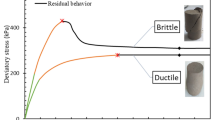Abstract
The lithomargic clay constitutes an important group of residual soils existing under lateritic soils. This soil is found on the western and eastern coasts of India over large areas. This soil is a problematic one and is very sensitive to water and loses a greater part of its strength when becomes saturated. These high silt deposits have invited many problems such as slope failures, foundation failures, embankment failures, uneven settlements etc. In this investigation an attempt is made to study the effect of cement and quarry dust on shear strength and hydraulic characteristics of the lithomargic clay after the stabilization. Microfabric and mineralogical studies were carried out to find out the reason for the strength development of the stabilized soil using SEM and XRD analysis. The results indicated that there is an improvement in the properties of the lithomargic clay with the addition of cement and quarry dust. The XRD results indicated the formation of CSH and CAH, which are responsible for strength development in the stabilized soil.


















Similar content being viewed by others
References
Achari R, Shivshankar R (2005) Studies on Anisotropy and Behaviour of Blended Shedi Soil. M Tech thesis, Department of Civil Engineering, NITK Surathkal
Al-Rawas AA, Hago AW, Al-Sarmi H (2005) Effect of lime, cement and Sarooj (artificial pozzolan) on the swelling potential of an expansive soil from Oman. Build Environ 40:681–687
Hausmann MR (1990) Engineering principles of ground modification. McGraw-Hill, New York
Khoury NN, Zaman M, Laguros JG (2004) Use of XRD patterns to evaluate compressive strength of stabilized aggregates. In: International center for diffraction data 2004, Advances in X-ray analysis, vol 47. pp 379–384
Prusinski JR, Bhattacharja S (1999) Effectiveness of Portland cement and lime in stabilizing clay soils. Transportation Research Record 1652, TRB, PCA
Puppala AJ, Griffin JA, Hoyos LR, Chomtid S (2004) Studies on sulfate-resistant cement stabilization methods to address sulfate-induced soil heave. J Geotech Geoenviron Eng, ASCE 130(4):391–402
Ramesh HN, Nanda HS (2007) Strength behaviour of shedi soil treated with fly ashes. 13th ARC 2007, Kolkata, pp 893–896
Ravishankar AU, Suresha SN, Phanikumar MVS (2006) Strength behavior of shedi soil-lime-pond ash mixes—an experimental study, Highway Research Bulletin, April 2006, Indian Roads Congress, New Delhi
Soosan TG, Sridharan A, Jose BT, Abraham BM (2005) Utilization of quarry dust to improve the geotechnical properties of soils in highway construction. Geotech Test J 28(4):1–10
Author information
Authors and Affiliations
Corresponding author
Rights and permissions
About this article
Cite this article
Nayak, S., Sarvade, P.G. Effect of Cement and Quarry Dust on Shear Strength and Hydraulic Characteristics of Lithomargic Clay. Geotech Geol Eng 30, 419–430 (2012). https://doi.org/10.1007/s10706-011-9477-y
Received:
Accepted:
Published:
Issue Date:
DOI: https://doi.org/10.1007/s10706-011-9477-y




